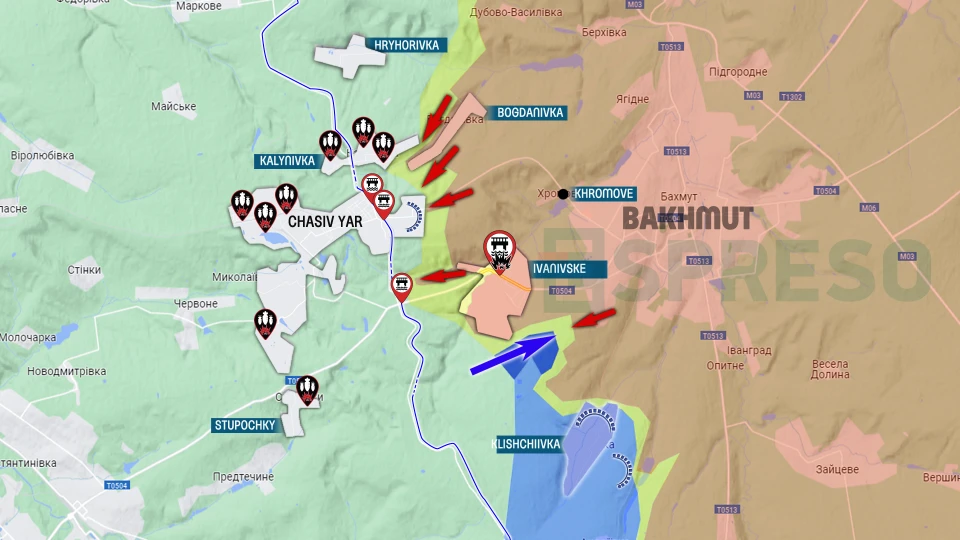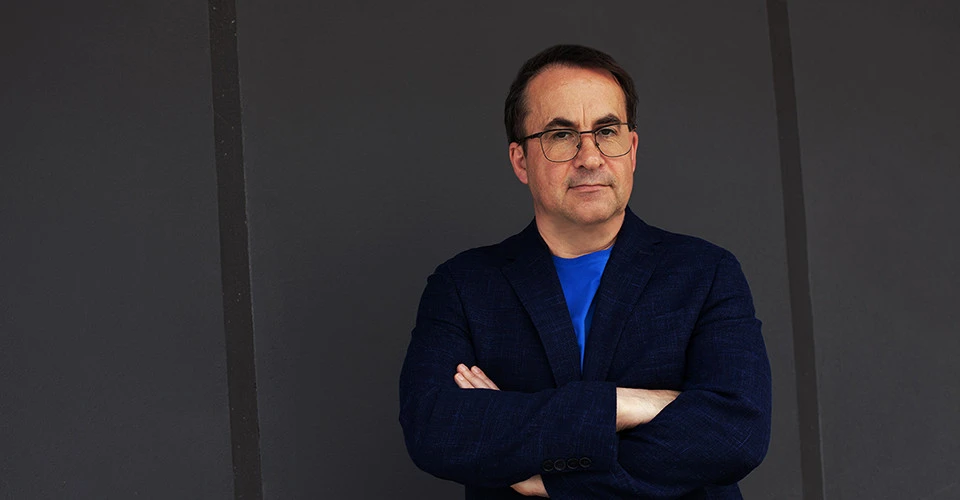
Frontline situation, negotiations with Russia, Ukrainian Defense Forces reform. Weekly military results by Serhiy Zgurets
The military summary covers frontline combat actions, forecasts from Ukrainian Defence Intelligence on potential Russian offensives, and ongoing Ukrainian Defense Forces reform amid the war
Interview with Vadym Skibitskyi on frontline situation
The situation on the frontline remained extremely difficult over the week. Three areas: Avdiivka, Bakhmut and Novopavlivka were the most tense, as stated by the Ukrainian Armed Forces Commander-in-Chief Oleksandr Syrskyi. The Russian forces are having some tactical successes in certain areas, and new details about the assessment of the frontline situation were added by the Deputy Chief of the Defense Intelligence of Ukraine, Major General Vadym Skibitskyi, in an interview with The Economist. The title of this article is quite alarming: Russia's new offensive will be a serious test for Ukraine.
According to The Economist, the situation for Ukraine is now perhaps the most difficult since the beginning of the active phase of the Russian invasion. According to the representative of the GUR, Russia is now throwing everything it has to achieve greater success. Regarding the number of Russian forces, the general announced that Russia now has a total of 514,000 personnel on Ukrainian territory. A month ago, the number was 470,000, which means that in this short period of time there has been an increase of 40,000 troops on Ukrainian territory, and now Russia is preparing an offensive in the northeast.
Skibitskyi, like Budanov, says that Russian activation is possible in late May or early June. Vadym Skibitskyi suggests that Russia is preparing for an offensive in the Kharkiv and Sumy regions, and this is actually the first statement from the leadership of the Main Intelligence Directorate.
Quantitative indicators are important now. The deputy head of the Defense Intelligence Agency says that the northern grouping of troops, which is located across the border from Kharkiv region, in Belgorod region, has 35,000 Russian personnel. I would add that they have not changed for a long time. So the enemy does not have such a build-up so far, and Skibitskyi also admits that these forces are not enough to capture the city, but some quick or provocative actions are possible when an attempt is made to break through the border and then Ukrainian troops will have to move reserves to this area. They say that Russia plans to increase this number to 70,000. But even 70 thousand is not really such an impressive figure.
Let me remind you that when the Russia forces tried to attack Avdiivka, 80,000 troops stormed the city, and 25,000 are now concentrated in the Chasiv Yar area, which means that 70,000 is certainly not enough to capture Kharkiv, but it may be enough for other actions to pull our reserves to this area.

As for other parts of the front, The Economist says that the Russians managed to break through the first line of defense near the village of Ocheretyne - it is true that the Russian troops are trying to expand this 25 km long bridgehead, but on the other hand, there is also information that certain brigades have now been relocated there from the Ukrainian side to block the Russian advance. This is an extremely important area, given the risks that further advancement of Russian forces may cause, in particular to the Donetsk-Kostiantynivka highway or towards Pokrovsk. These risks are known, so the Ukrainian General Staff is now taking measures to prevent this from happening.

Skibitskyi also made certain assessments regarding Chasiv Yar. He said that the Russian occupation of Chasiv Yar is likely, but it all depends on Ukrainian reserves and supplies - this is an absolutely correct conclusion. I can say that additional forces have now been deployed near Chasiv Yar to prevent the enemy from advancing. Although there are attempts to capture the entirety of Ivanivske from Bohdanivka, there have been no qualitative changes in the Russian troops' advance in recent weeks. This suggests that Ukrainian defense is quite effective. By the way, ammunition has also appeared there, allowing us to destroy the enemy more effectively.
The important point that Skibitskyi made is that even if we reach the 1991 borders, it does not mean that the war will end, because wars must end with negotiations and treaties. Now both sides are trying to take the most favorable position before potential negotiations, but according to the general, meaningful negotiations are possible no earlier than the second half of 2025. In any case, we understand that these are difficult times for Ukraine and the Ukrainian Armed Forces.
Challenges for the military at the front
Valentyn Badrak, Center for Army, Conversion and Disarmament Studies director, says the situation on the front line is difficult, but not critical.
“There has been no extraordinary build-up in the groups, perhaps there are some tricks, because according to some reports, they are increasing one or two battalions in each unit. It is not a problem for the Kremlin to recruit people, the problem is to train them properly. Back in March, when we made our assessments, we thought that the readiness for a major offensive, I would say a strategic offensive, was possible at the level of August or even early September, but this does not mean that there will be no offensive now and that the offensive can only be tactical. Because even the buildup that has been carried out allows for pressure, especially against the backdrop of a shortage of ammunition and weapons, which is a very big problem even after the decision of the United States,” the military expert believes.
At the same time, he stressed that there was no regrouping within the state, as Badrak's sources said that the State Service for Special Communications and Information Protection, which receives considerable resources and purchases a huge amount of ammunition, ground robotic systems, controls, and automated communication systems, is delaying the transfer of supplies to the military for 1.5-2 months: “The military say that if we are fighting 24/7, why don't officials want 24/7 during the war? This really violates the principle of the military doctrine adopted in 2021, which approved the overarching principle of defense, that the whole nation, the whole country must fight.”
Preparing the information space for possible negotiations
The military expert drew attention to the statement of Ukrainian Foreign Minister Dmytro Kuleba, who emphasized that Russia is more effective at the front. This is due to the fact that the pace of aid delivery is very slow and imperfect. And Army Commander Oleksandr Pavliuk noted that victory over Russia is possible only if it is completely isolated. The G7 countries are no longer considering the possibility of transferring frozen Russian assets; instead, they are offering the Russian Federation to return the occupied Ukrainian territories.
“In fact, a series of political statements is convincing evidence that the parties are preparing for negotiations and the parties are trying to be in a strong position. For example, the United Kingdom, as Foreign Secretary Cameron noted when he visited Kyiv, does not mind if Ukraine uses their weapons and hits Russian territory. Almost simultaneously, French President Macron reiterated that if the frontline falls apart, French soldiers will appear in Ukraine. These are still political statements, but what are they for? They are made in order to have a strong position at the talks scheduled for mid-June in Switzerland,” Badrak said.
He emphasized that China will play an extremely important role in the negotiations at the Peace Summit if it participates. And China can only join if it sees opportunities for change. For us, this will mean the paradigm of ending the war: “China really wants to do this, of course, pulling the blanket over to the Kremlin's side, which is understandable, but if China does not participate, then this can be interpreted in two ways. Either Russia feels strong enough and moves forward with the offensive, or vice versa - the initiative has been intercepted and China has nothing to offer, and Putin does not agree to withdraw from the occupied territories.”
Ukrainian Defense Forces reform in a war time
The Ministry of Defense has announced that a group has started working in Ukraine to create a model of an integrated defense system. It is not yet known what the directions, results, and goals of creating such an integrated defense system are within the framework of reforming the defense system as a whole.
“One of the key issues, in my opinion, is to link the restructuring of the Armed Forces with military-technical cooperation. Unfortunately, so far, the military and political leadership of the state has been acting on the proposals of various partners, and this has resulted in some poor decisions, I would say. For example, making a Fuchs combat vehicle together with Rheinmetall is two steps backwards. Because we can do it ourselves, whereas with Rheinmetall we need to make air defense systems, for example,” Badrak said.
This year, arms manufacturers have been emphasizing the need for standardization of unmanned aerial vehicles, given that the Armed Forces have more than 60 different types of UAVs in their arsenal: “The state cannot take the courage to do so, because it has not developed a mechanism to take the best from all developers: to hang up the Luch missiles, the guidance system we have, and make an anti-tank attack drone.”
- News













































